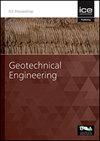The application of inspection and monitoring in the reduction of risk for mine tailings dams
IF 1.7
4区 工程技术
Q3 ENGINEERING, GEOLOGICAL
Proceedings of the Institution of Civil Engineers-Geotechnical Engineering
Pub Date : 2022-03-10
DOI:10.1680/jgeen.20.00248
引用次数: 1
Abstract
The recent high-profile failures of mine tailings dams across the globe have once again raised geotechnical interest in these structures. Much of the recent discussion in the technical press has concerned the prediction of ultimate stress state and thus of the failure potential of the tailings materials. The concentration solely on geomechanical properties is important in the understanding of the fundamental characteristics of extractive waste but limits the appraisal of risk potential in these complex and multifaceted structures. It is evident from the author's study of failures of these extractive waste facilities over a period of some 50 years that knowledge of geomechanical properties alone would not have prevented disasters in many instances. The paper reviews the fundamental risks posed by these structures with respect not only to their design but to their construction, operation and eventual closure. The analysis confirms that other crucial elements of their design and construction, if neglected, potentially pose higher risks than a lack of knowledge of geomechanics alone. The paper presents a broad list of risk reduction criteria which should be applied to mine tailings dams, and cites examples of where and how such neglect has resulted in the recent high-profile failures. The paper concludes with a review of general risk reduction criteria and compares these with existing standards and guidelines.检查监测在矿山尾矿坝风险降低中的应用
最近全球范围内备受瞩目的尾矿坝溃坝事件再次引起了人们对这些结构的岩土工程兴趣。最近技术报刊上的许多讨论都是关于预测尾矿材料的极限应力状态,从而预测尾矿材料的破坏潜力。仅关注地质力学性质对于理解采掘废物的基本特征很重要,但限制了对这些复杂和多方面结构的潜在风险的评估。从作者对这些采掘废物设施在大约50年期间的失败进行的研究中可以明显看出,在许多情况下,仅凭地质力学特性的知识并不能防止灾难的发生。本文回顾了这些结构所构成的基本风险,不仅涉及它们的设计,而且涉及它们的建造、运营和最终关闭。分析证实,如果忽视其设计和建造的其他关键因素,可能会比仅仅缺乏地质力学知识带来更大的风险。本文提出了一份应适用于矿山尾矿坝的降低风险标准的广泛清单,并举例说明了这种忽视在哪里以及如何导致最近引人注目的失败。本文最后回顾了一般的风险降低标准,并将其与现有的标准和指南进行了比较。
本文章由计算机程序翻译,如有差异,请以英文原文为准。
求助全文
约1分钟内获得全文
求助全文
来源期刊
CiteScore
4.40
自引率
4.50%
发文量
68
审稿时长
3 months
期刊介绍:
Geotechnical Engineering provides a forum for the publication of high quality, topical and relevant technical papers covering all aspects of geotechnical research, design, construction and performance. The journal aims to be of interest to those civil, structural or geotechnical engineering practitioners wishing to develop a greater understanding of the influence of geotechnics on the built environment.

 求助内容:
求助内容: 应助结果提醒方式:
应助结果提醒方式:


